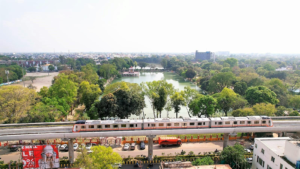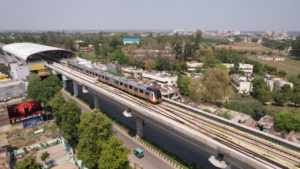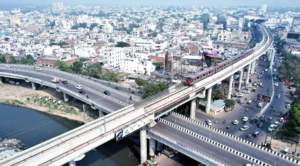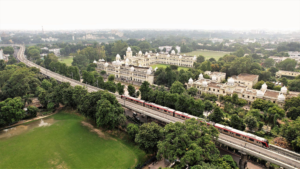
Interview Insights:
Rail Analysis: Please tell us more about your journey with UPMRCL? What have been the challenges you have faced since your appointment as the Hon’ble MD and how have you managed to resolve them?
Shri Sushil Kumar: My journey with Uttar Pradesh Metro Rail Corporation has been a very fruitful and enriching experience for me. Before assuming the charge of Managing Director, Uttar Pradesh Metro Rail Corporation, I was working in the capacity of Director Operations in UPMRC and looking after the entire operations of Lucknow and Kanpur Metro. After taking over the charge of MD UPMRC, the responsibility has grown many folds yet the satisfaction and happiness that comes after serving our proud passengers is incomparable.
Needless to say, in every ongoing as well as operational project, there are many challenges which we face on a day to day basis. For example, even today, there is a certain degree of Reluctance among people to opt for metro. Even after a metro project has been commissioned and is being operated successfully in the city, people are hesitant to take metro and do not want to make it a part of their day to day commute. A majority of people still prefer to use their personal vehicles (two wheelers and four wheelers) instead of metro, which adds to congestion on roads and traffic jams.
“UPMRC has initiated many tie-ups with taxi services like Rapido (bike taxi) and Wow Taxi to cater to the problem of last mile connectivity. Making this shift and Changing this mindset by making them accustomed to metro travel is a very big challenge.”
Increasing non fare box revenue is also one major challenge we face as an organization. While the fare box revenue generation is more or less fixed for any metro rail organization as ticket fares are decided after much thought and deliberations keeping in mind the socio-economic and demographic aspects of the city, increasing the non fare box revenue to meet growing operations and maintenance expenses is a challenge.
Developing other land projects (CG City in case of Lucknow Metro), Ensuring maximum revenue from Property Development area inside metro stations and constantly devising new methods of generating non – fare box revenue is a big challenge for us.
Other challenges which may be faced are securing financial aids for construction as well as maintenance of the project. Developing and expanding MRTS networks involves complex infrastructure projects that can face delays due to land acquisition, regulatory approvals, and technical challenges. Also, Integrating MRTS with existing urban infrastructure and transportation systems is vital for the system’s success. Ensuring smooth operations, timely maintenance, and minimizing downtime can be challenging, especially as systems become more and extensive and expand in the city.
“A metro rail system is planned for a city that is already inhabited and has expanded in all directions. Planning the alignment for executing the metro project in that city involves many challenges; For Example.”
Keeping in mind the historical monuments and old buildings which are sensitive to any construction activity, diversions which may arise due to metro construction, probable impact on traffic during construction phase, utility diversion or repair work during construction, etc. Keeping up with technological advancements and integrating new innovations can be a challenge, but it’s essential for improving efficiency, user experience, and sustainability.
Rail Analysis: Please share more about the recent achievement of Kanpur Metro Rail Project which has been awarded with the first prize under the category of Environmental Protection by Greentech Foundation?
Shri Sushil Kumar: I am happy with current achievement of the Kanpur Metro Rail Project which has been felicitated with the first prize under the category of ‘’Environmental Protection” by Greentech Foundation. We are indeed committed in our resolve to provide steadfast ‘Green Mobility Solutions’ to the people. Metro mitigates the pollution by taking off millions of vehicles off the roads. The infrastructure developed by UPMRC in Lucknow, Agra and Kanpur is constructed as per the international green building codes.

View of Kanpur Metro
Hence, at the same time, we are simultaneously complying with the sustainable development goals of the ‘UNDP – United Nations Development Program’. We aspire to create self sustainable infrastructure that assimilates easily with the energy needs of running routine operations of the metro. In totality, the endeavors of our team are delivering good results. All metro projects of UPMRC are sustainable and adopt multiple Green Initiatives like: Harnessing Solar Energy: A 1.28 MW capacity solar plant has been installed at the Administrative Building premises along with 1.1 MW capacity solar plant at Transport Nagar Metro Depot.
For Kanpur Metro as well, similar set up has been established in Kanpur Metro Depot, all stations and RSS Building. 1 MW capacity solar plant has been installed in Kanpur Metro depot, while 10KW capacities each solar panels have been installed at CSA and Phoolbagh RSS Building. Rain water harvesting:
In 23 km long stretch of North-South more than 300 rain water harvesting pits have been created with a capacity to harvest 20 lakhs litres of water. Similar arrangement has been planned in Kanpur and Agra Metro. It is expected that upon completion of the Projects they will create additional 15 lac – 20 lac litre rain water harvesting capacity in the city of Kanpur and Agra.
Regenerative Energy in Trains and Lifts:
The rolling stock of Kanpur and Agra Metro Project has an efficiency of 45 per cent through regenerative braking technology. Besides rolling stocks Regenerative Braking is also used in lifts of all UPMRCL Projects. The lifts in various Uttar Pradesh Metro premises recorded almost 37% energy efficiency. Along with this, the Kanpur Metro trains have a carbon-dioxide sensor based air-conditioning system, which operates according to the number of passengers present in the train and saves energy.

Kanpur Metro Station
Relocation and Transplantation of Trees:
In Lucknow Metro Project, more than 400 trees were transplanted with survival rate of more than 95%. Similar model has been followed in Kanpur, where till date more than 100 big trees have been transplanted under the priority section of Kanpur metro project. UPMRCL has strong commitment to safeguard every possible tree coming in the Metro alignment and to keep the number of trees to be cut down, as minimum as possible.
Rail Analysis: It is evident that Indian Railways and Metros are reforming and giving a huge contribution in the Indigenisation of technology in our industry. In that context, what is the level of indigenisation that UP Metro has reached till now?
Shri Sushil Kumar: I would like to admit that today Railway and Metro Rail Industry are a huge contributor towards indigenization of technology. This step also contributes to our country’s growth and leads to saving of valuable time and resources which earlier had to be imported from other countries.
UPMRC is a major contributor in this field as all the metro coaches for Lucknow, Kanpur and Agra Metro Projects are made in India on the lines of Government of India’s ‘Atma Nirbhar Bharat’, which aims to make India self reliant in every field, most important of which is technology.
Metro coaches for Kanpur and Agra are made in Savli, Gujarat and were transported from there to respective project sites. More and more encouragement is given to Indigenous technology models to be implemented in any ongoing metro project.
Energy saving model adopted by UPMRC:
UPMRC is procuring electricity for Lucknow Metro operation maintenance through Indian Energy Exchange (IEX) under ‘open access model’. The corporation has opted this model in December, 2022 and managed to save Rs. 7.50 lacs in the first month. From December to July, which is approximately six months, UPMRC was able to save more than Rs. 1.5 Crores, which is a tremendous feat in itself.

View of Lucknow Metro
Lucknow Metro has become the first Metro Project in the state to opt for this model. With saving Rs. 45 lacs in the past month, Lucknow Metro has set an example in this field for the Metro Projects operating in tier-2 cities of the country.
Rail Analysis: Will there by any participation of UPMRCL in the under construction Delhi-Meerut RRTS Corridor and Meerut Metro project. Would you also be managing the Meerut metro or any connectivity with your existing projects?
Shri Sushil Kumar: Talking about Meerut Metro, the DPR ( Detailed Project Report) Prepared for Meerut Metro identified two corridors to be implemented. The first corridor ( Corridor – I) will be from Partapur to Modipuram (18 km) of Meerut Metro which will be coinciding with RRTS corridor in Meerut City.
The corridor has been merged with RRTS being implemented by National Capital Region Transport Corporation (NCRTC). Uttar Pradesh Metro Rail Corporation will likely be implementing the second corridor – which is marked from Shradhapuri Ph-2 to Jagriti Vihar Extension and is around 15 kms long.
Rail Analysis: In the recent Global Investor Summit of 2023, EIB pledged to invest 3 billion Euros in UPMRCL upcoming metro corridor projects, what are your major projects which will get initiated by this fund under UPMRCL?
Shri Sushil Kumar: European Investment Bank, which is a major financial body in the world has financed Lucknow, Kanpur and Agra Metro Projects in Uttar Pradesh. The European Investment Bank (EIB) is proud of its contribution to all the metro projects in UP because it will improve the quality of life for the citizens.
After financing Agra Metro Rail Project after Lucknow and Kanpur Metro Project, (Agra being the sixth urban metro rail project that EIB supports in India) , it brings EIB’s total approved commitments to the sector to over 3 billion euros, of which over 2 billion euros have been signed.
“UPMRC is thankful to European Investment bank for their continued support to the development of Metro rail projects being implemented in the state of Uttar Pradesh. After funding the Lucknow Kanpur Metro projects, EIB is providing full support for Agra Metro project also. Timely disbursements of funds from EIB accelerate the speed of work and helps in re-emergence of the local economy.”
It is to be noted that the European Investment Bank (EIB) shall be funding EURO 450 Million for the Agra Metro Project, which is made available to UPMRC through gross budgetary resources in the form of Pass- Through Assistance (PTA) from the Government of India.
EIB has also expressed its interest in financing Gorakhpur Metrolite Project as and when it is sanctioned and according to EIB has also expressed its interest in financing Gorakhpur Metrolite Project as and when it is sanctioned and according to EIB, many tier 2 cities of Uttar Pradesh have immense potential for a metro system.
Rail Analysis: The Uttar Pradesh government is focusing on expanding Metro rail services in Gorakhpur, Varanasi, Meerut, Bareilly, Jhansi and Prayagraj. Any update on them and what are the major points of sustainable development UPMRCL will consider in making these projects?
Shri Sushil Kumar: Uttar Pradesh Metro Rail Corporation will execute metro projects in major cities of UP, subject to government approval. The project will likely operate as a metro-lite system and the DPR consists of two corridors from Shyam Nagar to MMM Engineering College and BRD Medical College to Naushad Chauraha. The Revised DPR was submitted to Government of Uttar Pradesh. Subsequently, the DPR approved by State.

Lucknow Metro passes near Lucknow University
For Varanasi Metro Rail Project, in order to explore alternate possibilities of Public Transport, RITES was engaged by Varanasi Development Authority to explore Ropeway System along with Integrated Multi Modal Public Transport for Varanasi city. In the Comprehensive Mobility Report, RITES has suggested implementation of MRTS corridors in two phases.
Phase-1: Corridor-1: BHU to BHEL- 16 km
Phase-2: Corridor-1: Kashi MMH to Sarnath- 7 km
Speaking about Prayagraj Metro Rail Project, Draft DPR for Metro system is being prepared by RITES and is under consideration of the authorities. Two Corridors of total length 42.4 km has been considered in the DPR. Corridor-1 is from Bamrauli to City Lake Forest of length 22.30 Km with 16 elevated and 2 underground stations. Corridor-2 is from Shantipuram to Cheoki of length 20.11 km with 16 elevated stations. Similarly, Bareilly, Ayodhya and Jhansi Metro System are also in planning stage and will soon be sent for approval.
Rail Analysis: There have been several proposals made by UP Government for Mathura-Vrindavan Metro Corridor & ‘Braj Heritage Metro Train Corridor’ under the Smart City plan. When can we see these projects get initiated by UPMRCL?
Shri Sushil Kumar: The government is planning to develop Mathura and Vrindavan as a major pilgrimage and tourist site and integrating the area by various means of transport. The proposed mass transit system between Mathura Vrindavan corridor will comprise a two-third lane road along with a metro transit system/light rail that can withstand the high footfall of tourists.
The project also involves the development of parking zones and commercial establishments such as hotels. Markets , etc in the region. An estimate is being prepared and State and local administration under the smart city plan are working on these plans. May be in the future, government may make some important announcements.
Rail Analysis: Anything else you would like to share with our readers?
Shri Sushil Kumar: The present trend of awarding the O&M by the Metros will grow progressively and the revenue in this stream will increase manyfold.
“UPMRC is fully committed to provide the residents of Uttar Pradesh a network of metro systems that will provide seamless connectivity, safe secure and premium travel experience, environment friendly means of transportation that will prove to be indispensable for the respective city.”
I urge more and more people to use metro as a means of travel wherever metro is operational (in Lucknow and Kanpur) and very soon, it it will be operational in Agra and hopefully all major cities of Uttar Pradesh.
This Interview is a part of our latest Magazine: Subscribe to our Magazine Today!

